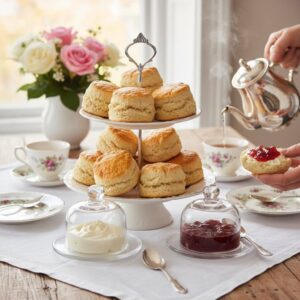There are few treats more quintessentially British than a light, fluffy scone, especially when served warm with generous dollops of jam and clotted cream. If you want to achieve baking perfection, there’s no better guide than the Queen of Baking herself, Mary Berry.
This Mary Berry scones homemade recipe is the gold standard, promising tender, well-risen delights that are perfect for your next afternoon tea. Read on to discover the recipe, the history behind this humble bake, and the ideal time to enjoy it.
What are Scones? A British Baking Staple
Before diving into the recipe, let’s answer a common question: what is a scone?
A scone is a traditional British and Irish baked good, a form of quick bread. They are similar in texture to American biscuits but are typically less savoury (though savoury cheese scones do exist!) and are often lightly sweetened. Scones are traditionally made from wheat flour or oatmeal, with baking powder as the leavening agent, which gives them their characteristic rise and light, airy texture.
Originating in Scotland, the scone became a crucial element of the fashionable ritual of Afternoon Tea in England, popularized by the Duchess of Bedford in the 1840s.
The key to a perfect scone, as Mary Berry often stresses, is a light touch. The dough should be handled as little as possible to prevent the development of too much gluten, which would result in tough, heavy scones.
Also Read: Easy Lemon Drizzle Traybake Recipe – Moist, Zesty & Perfect for Afternoon Tea
Mary Berry’s Classic Scones Recipe
Mary Berry’s recipe is celebrated for its simplicity and the consistently superb results it yields. Her secret? Not overworking the dough and ensuring the mixture isn’t too dry.

Classic Scones Recipe
Ingredients
- 225 g Self-raising flour
- 1 tsp Baking powder
- 50 g Butter (chilled, cut into cubes)
- 25 g Caster sugar or 50g for sweeter
- 1 Large egg
- Approx. 125 ml Milk
Instructions
- Preheat & Prep: Preheat your oven to 220°C. Lightly grease a baking sheet.
- Combine Dry Ingredients: Measure the flour and baking powder into a large bowl. Add the chilled butter cubes.
- Rub in the Butter: Use your fingertips to quickly and lightly rub the butter into the flour mixture until it resembles fine breadcrumbs. Stir in the sugar.
- Add Wet Ingredients: Crack the egg into a measuring jug, lightly beat it, and then make it up to 125ml (4 fl oz) with milk.
- Form the Dough: Keep about 1 tablespoon of the egg/milk mixture aside for glazing. Stir the rest of the liquid into the flour mixture using a round-bladed knife, mixing quickly to form a soft, slightly sticky dough. Do not overmix.
- Shape & Cut: Turn the dough onto a lightly floured surface and knead it very lightly just to bring it together. Gently roll or pat it out to a thickness of about 1.25cm (½ in). Use an 8cm (3in) fluted cutter to stamp out rounds, pushing the cutter straight down (do not twist) to ensure a good rise. Re-form and cut the remaining dough.
- Bake: Place the scones on the prepared baking sheet, spaced slightly apart. Brush the tops with the reserved egg/milk mixture to glaze.
- Cook: Bake for about 10-12 minutes, or until they are well-risen and a pale golden-brown colour.
- Cool & Serve: Remove from the oven and transfer to a wire rack to cool slightly. Scones are best served warm.
Notes
Notes on Servings:
- Standard Yield: The smaller recipe (using 225g or 8oz of flour, as written in the article) yields 10 scones when using a standard () cutter.
- Larger Recipe Variation: Many of Mary Berry’s recipes online use () of flour. This larger batch typically yields 16 to 20 scones, depending on the size of the cutter you use ( or cutters will yield more, smaller scones).
Also Read: Mary Berry Date and Walnut Cake: A Classic Moist Loaf You’ll Love
The Best Time to Eat Scones
While the short answer is “anytime!”, scones have a traditional and an optimal moment for enjoyment:
1. The Traditional Time: Afternoon Tea
Scones are inseparable from the tradition of Afternoon Tea, which is typically served between 3:00 PM and 5:00 PM.
In a traditional afternoon tea service, scones are served on the middle tier of the tiered stand, following the savoury sandwiches and before the sweet pastries and cakes. This is the classic setting to enjoy them with clotted cream and jam (don’t forget the great debate: jam first – the Cornish way, or cream first – the Devonshire way!).
2. The Optimal Time: Warm and Fresh
The true best time to eat a scone is when it’s freshly baked and still warm from the oven. The texture is at its most light and tender, making it melt in your mouth.
If you bake them earlier, a quick warm-up in a low oven or even a gentle blast in the microwave will bring back some of their wonderful softness.
3. As a Mid-Morning or Brunch Treat
For a less formal occasion, a warm scone makes a wonderful treat for mid-morning elevenses with a cup of coffee or tea. Many also enjoy them as a comforting addition to a relaxed brunch spread.
Whether it’s the centerpiece of a full Afternoon Tea or a simple mid-morning treat, a homemade scone made with Mary Berry’s flawless technique is a little slice of heaven. Happy baking!
Disclaimer
We are an educational platform, not professional counselors, therapists, or medical experts. The content on this blog is for informational purposes only and should not be taken as professional parenting, medical, psychological, or legal advice. Every family and child is unique, and what works for one may not work for another. Always seek guidance from qualified professionals before making decisions about your family’s health, education, or well-being. I share my personal experiences here purely for entertainment purposes, so please do not take them too seriously or apply them to yourself without proper consideration.



